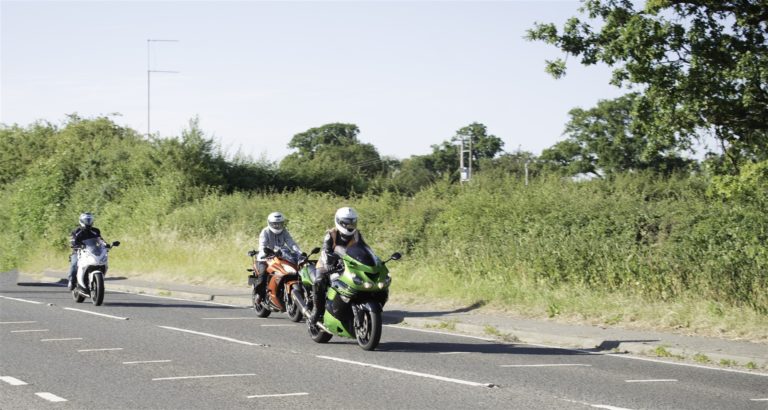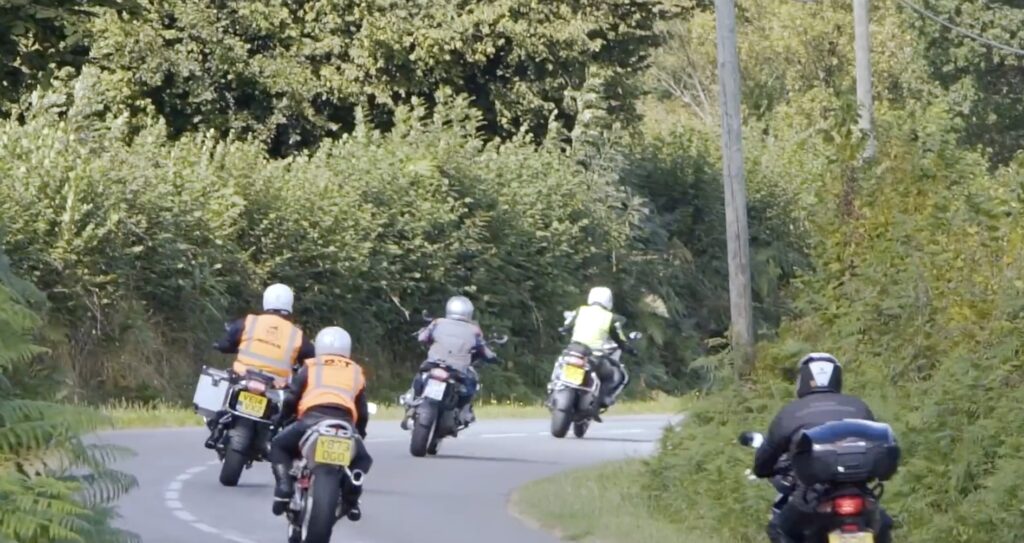

Group Riding Tips for Motorcycle riders
There are a number of ways the group can ride when they are riding motorcycles together. In a previous article we discussed group dynamics and some great Group Riding Tips. There are many more Group Riding Tips For Motorcycle Riders and considerations that should be taken into account.
Once a briefing has taken place and everyone knows what their roles and responsibilities are, it’s important not to set off too quickly. This is because it takes time to settle into Group Riding and get an insight and feel how the other riders around you ride.
Going too quickly to start with will show the wrong message to all riders in the group. Inexperienced riders could feel like they are riding on the edge of their ability and not like the thought of staying with the group for the rest of the ride. Don’t show off to other riders with less skill or ability than yourself.
The briefing should discuss some of the following information. Those who are new to Group Riding should be taught how to ride and given information on what to expect during the ride.
If you ride regularly as a group, it might be a good idea to break the group into experienced and non-experienced riders. This will mean a proper training program can be adapted to train inexperienced riders how to ride on future group rides.
Some things to think about and consider are listed below;
Staggered formation is where riders offset themselves to each other while they are on the move.
This means that when riding in the UK or in countries that drive on the left-hand side of the road, the first rider will ride in the right-hand wheel track and the second rider in the left-hand wheel track. This is then copied all the way back down the line where each rider will be offset from the rider in front and behind them.
If each rider was given a number (either 1 or 2). This would mean that all odd-number riders would be on the right-hand side of the lane and all even-numbered riders would be on the left-hand side of the lane.
Staggered formation can be adopted on all straight roads. e.g. where there is no advantage to moving position for a better view (say, when cornering). The staggered formation will give a better view and also give the rider a longer braking area, a greater margin for error and a safer distance in front, if necessary.
Staggered formation can be used in a number of situations to make the view greater which gives more space and time. Use staggered formation on long straight roads, dual carriageways, motorways, villages, towns and cities and also in speed limits of 30 and 40 mph.
Single file riding can be used when on higher speed limits like 50 and 60mph roads that are not straight. Especially when negotiating twisty roads when cornering, country lanes, and A and B roads. Following and copying a more experienced rider, it will help adopt the correct road positioning for view and extended safety margins with riding position.
Riding in pairs can also be used when riding within a group, especially when the route is not well-known by all riders. It means that if anyone gets separated from the group they will never be alone and will have the benefit of having a riding partner. This is also important in the event of an accident, breakdown, or getting lost.
The way pairs work is, the lead rider of the pair will ride nearer to the centre line of the lane, this will give them the view for overtaking and also a clear view of what is going on behind. The second rider is almost a wing-man, as they ride slightly behind and in the nearside mirror view of the first rider. This way the front rider will always know where the second rider is at all times.
This becomes even more important at higher riding speeds and especially if the two riders do not know each other. It is a safe way of riding, as both riders can take turns being first or second in their pair. This will help both riders gain experience and an understanding of the other person’s riding style and ability.
When riding in a group and not the lead pair. The first rider in the pair has a job to do, and that is to keep in touch with the second rider of the pair in front of them. They should position so that they are in the offside mirror of the second rider in front of them so that that rider knows where the first rider of the pair behind is.
This system continues down the line until the last pair of riders.
Whenever the group stops at junctions, roundabouts, or in normal traffic flow. All riders should aim to double up with their partner and stop side by side next to each other. This will ensure the group is tighter together and does not get strung out over a longer distance.
All pairs can ride next to each other in slow-riding situations, as this helps to keep the group tighter together and not in a single file.
As an example, if there are 12 riders in the group and you ride in pairs, the lead rider (who is also a pair) only needs to count 5 bikes behind them (near the white line), to ensure they know all the group is together.
Doubling up helps to keep the group tighter together, also preventing other vehicles from forcing their way between the group of riders. Stopping in a long line behind one another could hinder progress. If you are stationary at a set of traffic lights and the lights turn to green, groups that double up have more opportunity to get through together before the lights change back to red.
Riding in a long strung-out line creates bigger gaps between riders and the possibility that not everyone will get through in one go. This will mean the group has split up and hinders progress.

When the group is riding in a staggered formation (one rider on the left and one rider on the right-hand wheel track), there are times when the riders on the left will need to move to the right-hand wheel track. Also there will be situations where the riders on the right will need to move to the left-hand wheel track. Because there is a gap between all the riders on the left, the riders on the right can move across into this gap and vice versa. Hence the term zipping up.
The simple reason why this would happen is if there were parked vehicles on the left-hand side of the road, the riders in the left wheel track will need to move position to give adequate clearance. They would move to the right (temporarily) and once they clear the hazard, they would move back to the left wheel track (unzipping back into their natural position).
Likewise, if there were parked vehicles on the opposite side of the road and there was oncoming traffic. The riders in the right-hand wheel track would move to the left in between the even-numbered riders until they have cleared the hazard. They would then move back into the staggered formation once they had passed the parked vehicles.
It is a simple procedure to practise, after all, it is about rider responsibility and group safety. If the group has some experienced riders, at least two of them should lead. This is so that the riders directly behind them can see what they are doing and copy their example.
After a few groups rides, it becomes more familiar and with practice, formation riding can look very impressive and professional to other road users.
Conclusion
Group Riding is an easy concept once you know what you are doing. However, practice really does make perfect. To start with, when there is a mixed group of riders who have never ridden like this before, the pace should be slower as everyone needs time to become comfortable.
It can be very dangerous for the group if speed becomes a priority over safety, always keep the speed down to the slowest rider’s ability. By doing this you will reduce the risk of multiple bike accidents.
Group Riding can be challenging with a mixture of motorcycles that have different characteristics, different riders abilities, weather and road conditions may not be ideal, and also the experience of the group riding together as a whole.
There are a lot of combined factors to consider when Group Riding, which is why the Lead Rider should be experienced and able to pass on their knowledge to other riders.
A good Group Ride is when everyone learns to ride safely with each other, they enjoy the experience and make it home safely in one piece at the end of the ride.
Ride Safe and Keep It On The Black Stuff #KIOTBS
Written by Simon Hayes
Become a member today to gain access to our courses and exclusive member content* including:
* Content may differ between each membership

Sorry. You must be logged in to view this form.
"*" indicates required fields